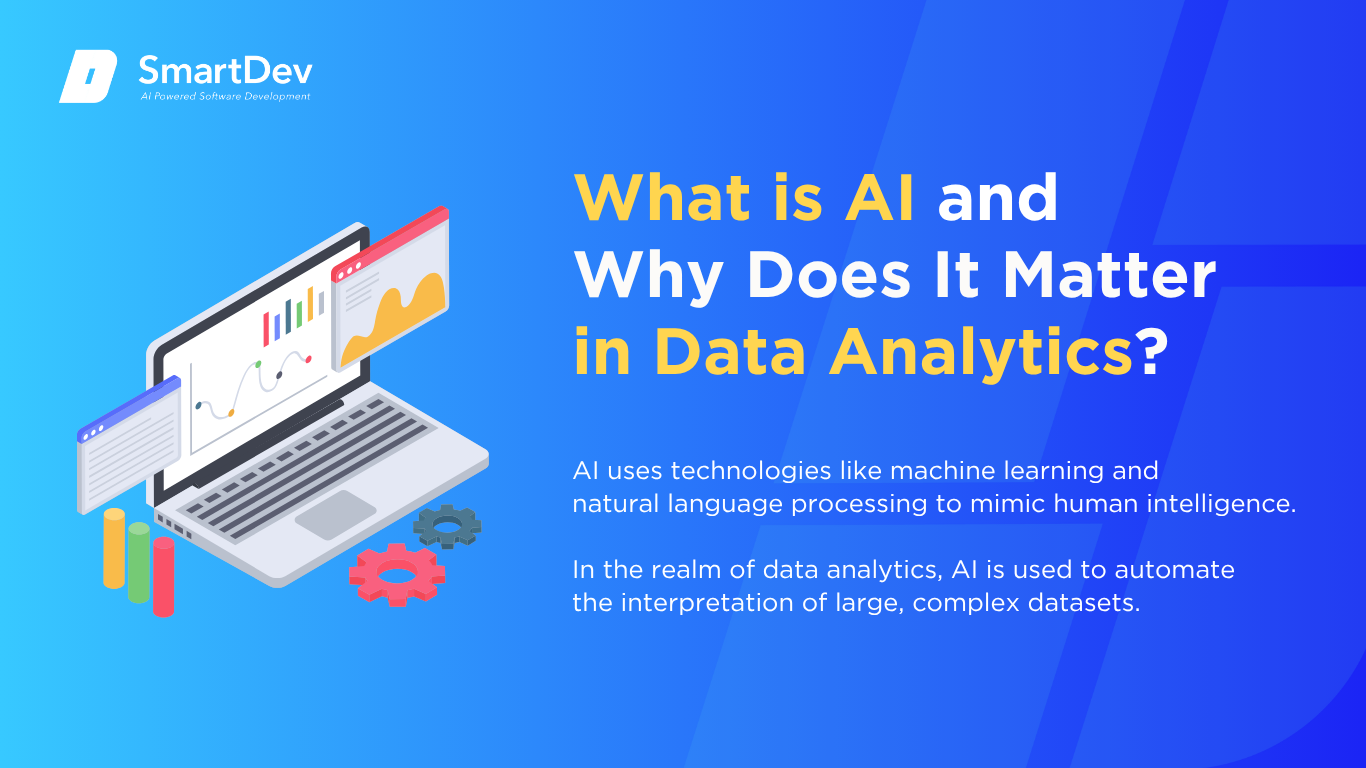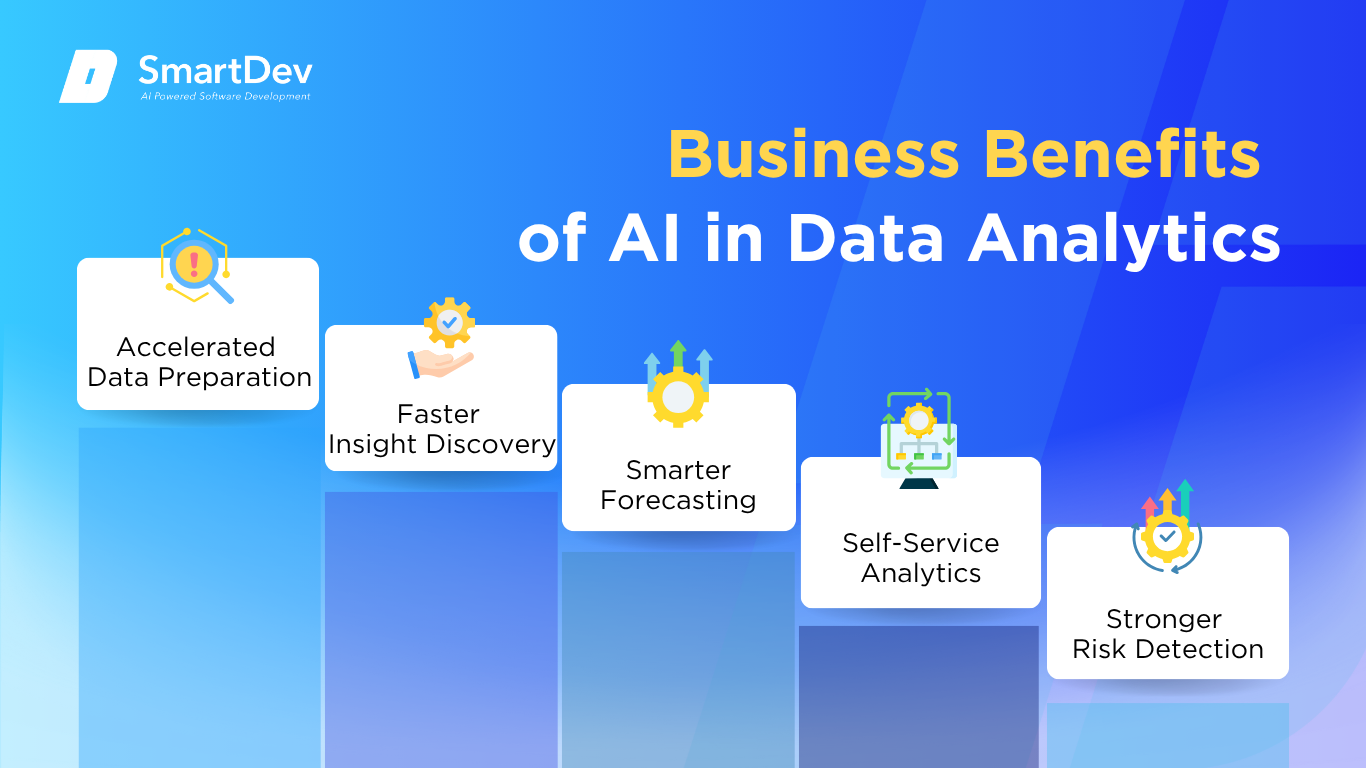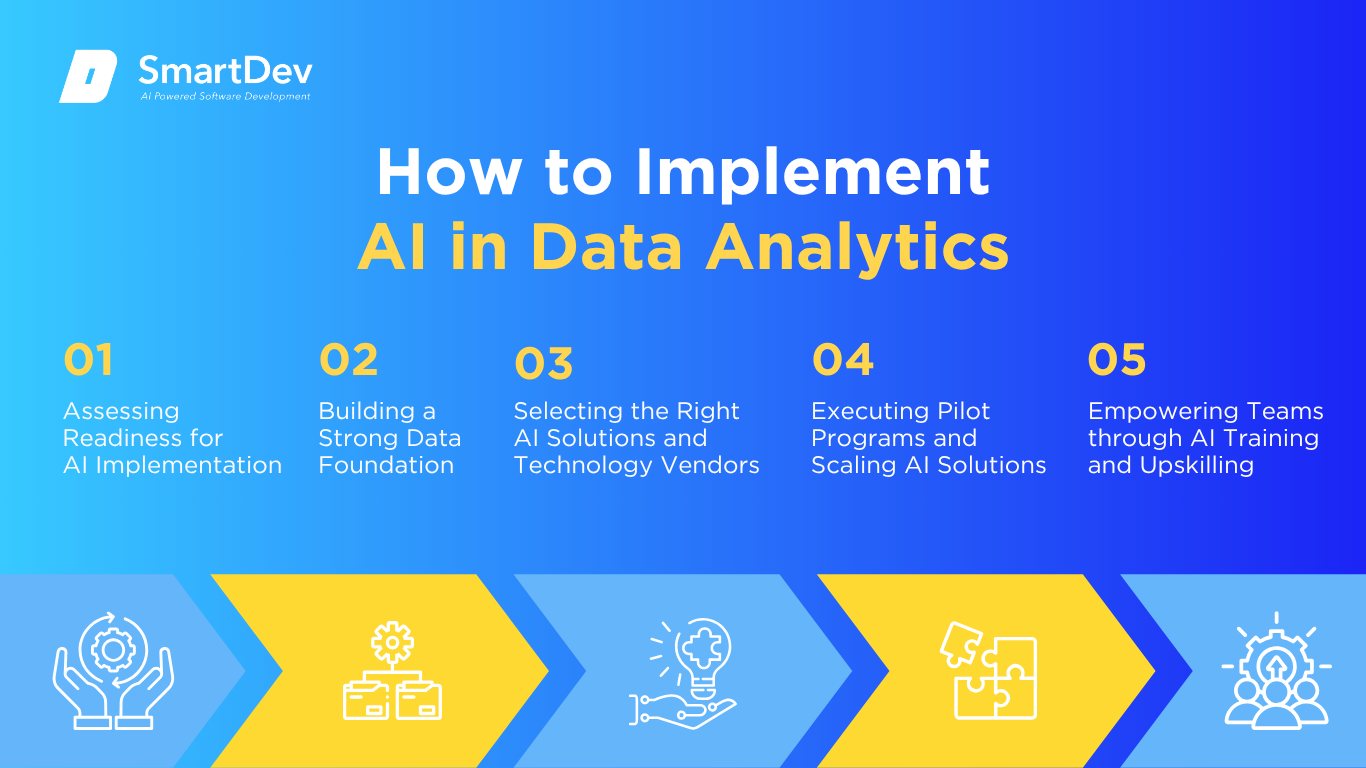Introduction
Data analytics faces escalating challenges: massive datasets, the demand for real-time insights, and a limited analytical workforce. AI’s rapid progress is revolutionizing analytics by automating data prep, spotting hidden patterns, and enabling predictive decision-making. This comprehensive guide explores AI’s most impactful use cases, benefits, and implementation hurdles in modern analytics.
What is AI and Why Does It Matter in Data Analytics?

Definition of AI and Its Core Technologies
Artificial Intelligence (AI) refers to the development of computer systems capable of performing tasks that typically require human intelligence. These tasks include learning from data, recognizing patterns, making decisions, and solving complex problems. AI’s foundation lies in technologies such as machine learning, natural language processing (NLP), and computer vision, which enable systems to improve performance over time.
In the realm of data analytics, AI is used to automate the interpretation of large, complex datasets. It helps uncover meaningful insights faster and more accurately than traditional methods by learning from past data and making predictions. This transformation enhances the ability of businesses to act on data in real time, improving strategic decision-making and operational efficiency.
The Growing Role of AI in Transforming Data Analytics
AI is transforming data analytics by automating routine tasks and accelerating data preparation. Analysts spend less time cleaning data and more time extracting insights. This shift improves both efficiency and decision-making speed.
Machine learning models detect patterns and anomalies that traditional tools often miss. These capabilities enhance accuracy and enable predictive insights that guide business strategy. Companies gain a clearer view of trends and future outcomes.
Natural language processing allows users to query data using everyday language. This makes analytics accessible to non-technical teams and encourages data-driven decisions across the organization. As a result, insights become faster, broader, and more actionable.
Key Statistics and Trends Highlighting AI Adoption in Data Analytics
In 2024, 78% of global companies reported using AI in at least one business function, up from 55% in 2023. Generative AI saw rapid growth, with adoption rising to 71% by year-end. Organizations now deploy AI across an average of three functions, reflecting broader integration beyond pilot projects.
In data analytics and finance, 55% of teams use AI for analysis and 47% for predictive modeling. Nearly one-third apply AI for anomaly detection, especially in risk and compliance contexts. Deep learning is used by 60% of AI adopters to enhance insights and forecasting accuracy.
However, only 26% of companies have achieved measurable business value from AI implementations. Despite this, U.S. private AI investment reached $109.1 billion in 2024, far surpassing other countries. This reflects strong confidence in AI’s transformative potential across industries.
Business Benefits of AI in Data Analytics
AI is driving measurable improvements across the data analytics lifecycle, from preparation to decision-making. By automating key processes and unlocking predictive insights, it enables faster, smarter, and more scalable analytics operations.

1. Accelerated Data Preparation
AI automates time-consuming tasks like data cleaning, normalization, and formatting, which can consume up to 80% of an analyst’s time. These tools detect missing values, standardize data structures, and eliminate redundancies with minimal human input. This speeds up analytics workflows and improves data quality across the board.
By reducing manual preparation, teams can redirect their focus toward analysis and strategic decision-making. This shift allows organizations to respond to insights faster and improves overall productivity. The streamlined process also minimizes errors and enhances consistency across datasets.
Explore our guide to AI model testing to understand how data quality and validation shape effective analytics models.
2. Faster Insight Discovery
AI rapidly analyzes large datasets to uncover patterns, trends, and anomalies that traditional methods may overlook. This ability helps businesses surface valuable insights that drive better understanding of customer behavior and operational performance. As a result, decisions become more informed and evidence-based.
The real-time processing capabilities of AI enable organizations to act swiftly on emerging data. Businesses can quickly adapt to changing market dynamics or internal shifts. This agility translates into a stronger, more responsive competitive edge.
3. Smarter Forecasting
AI-driven models predict future outcomes, such as demand, churn, or revenue, using historical data and pattern recognition. These predictive capabilities support more accurate planning and resource allocation. Over time, the models refine themselves, continuously improving accuracy.
Prescriptive analytics enhances this by recommending concrete actions based on those forecasts. For example, it can suggest supply chain adjustments or pricing changes to optimize results. This proactive approach helps reduce inefficiencies and supports forward-looking strategies.
4. Self-Service Analytics
With natural language processing, users can explore data using conversational language instead of technical queries. This removes barriers for non-technical staff and extends the reach of analytics across the business. Data becomes more accessible, empowering a broader base of users.
Employees in various roles can independently access insights without waiting for support from analysts or IT teams. This reduces bottlenecks and accelerates decisions at every level. In turn, the organization becomes more agile and aligned around data.
5. Stronger Risk Detection
AI enhances analytical accuracy by consistently applying logic across complex datasets, minimizing human error. This level of precision is especially important in sectors with strict compliance demands. It ensures outputs are both reliable and audit-ready.
In addition, AI excels at identifying anomalies and unusual activity in real time. It can monitor thousands of transactions instantly, spotting fraud or compliance issues as they arise. This early detection helps organizations mitigate risk and act before small issues escalate.
Challenges Facing AI Adoption in Data Analytics
Despite its promise, AI adoption in data analytics faces real-world obstacles that can limit impact. From data quality issues to talent shortages, overcoming these barriers is essential to realizing AI’s full value.

1. Data Fragmentation and Quality Issues
AI models rely on clean, consistent, and well-integrated data, but many organizations struggle with fragmented data sources. Information is often scattered across legacy systems, spreadsheets, and siloed platforms, leading to inconsistencies. These gaps make it difficult for AI to deliver accurate or meaningful results.
Without robust data governance, organizations face delays and inaccuracies in AI-driven insights. Data cleansing and consolidation require time, tools, and cross-departmental coordination. Until this foundation is addressed, AI’s full value in analytics remains out of reach.
Explore how data management best practices empower growth and resilience in this guide on the critical role of data for small businesses.
2. Infrastructure Complexity
Implementing AI in analytics demands scalable infrastructure, including cloud computing, data pipelines, and storage capacity. Many organizations lack the technical setup to support real-time processing or large model training. Without the right architecture, AI systems struggle to operate efficiently.
Upgrading infrastructure can be costly and requires specialized expertise to design and maintain. Teams may face challenges integrating AI tools with existing platforms and workflows. These barriers can delay deployment or limit AI’s reach across the organization.
3. Talent Shortage
AI initiatives depend on skilled professionals like data scientists, machine learning engineers, and analysts with AI literacy. However, there’s a global shortage of qualified talent to develop and maintain AI systems. This talent gap slows adoption and reduces the effectiveness of existing tools.
Organizations may rely on consultants or automated platforms, but these come with their own limitations. Upskilling internal teams takes time and investment, making it harder to scale quickly. Without the right expertise, AI implementations often stall or underperform.
4. Bias and Explainability
AI systems can inherit biases from training data, leading to skewed or unfair outcomes. In analytics, this can distort forecasts or misinform critical decisions. These risks make stakeholders cautious about fully trusting AI-generated insights.
Transparency is another concern, especially with complex models that lack explainability. If users can’t understand how conclusions are drawn, adoption suffers. Ensuring fairness and accountability requires careful model design and robust validation processes.
5. Workflow Resistance
Integrating AI into existing analytics workflows often disrupts established routines. Teams may be reluctant to trust automated outputs, especially when they lack visibility into how models work. Resistance can arise from fear of job displacement or loss of control.
Successful adoption requires thoughtful change management, including training and communication. AI should complement – not replace – human judgment, and that message must be clear. Without buy-in from users, even well-built systems may go underutilized.
Specific Applications of AI in Data Analytics

1. Predictive Analytics and Forecasting
Predictive analytics uses historical data, AI algorithms, and statistical techniques to forecast future outcomes. This is particularly valuable in sectors like retail, finance, and healthcare where anticipating customer behavior, financial trends, or disease outbreaks can lead to strategic advantages. AI enhances this process by enabling more accurate, scalable, and real-time forecasting models.
These models typically rely on machine learning techniques such as regression analysis, decision trees, and neural networks. Input data includes structured records from CRM systems, sales databases, or IoT sensors. AI systems continuously learn from new data, improving forecast accuracy over time and allowing for adaptive analytics that evolve with changing conditions.
The value lies in timely, data-driven decisions that reduce risk and seize opportunities. Businesses can optimize inventory, allocate resources more efficiently, and anticipate customer needs. However, challenges like data quality, model overfitting, and bias must be managed carefully to ensure trustworthy outcomes.
Real-world example:
Amazon uses AI-powered predictive analytics to forecast product demand, enhance customer personalization, and optimize delivery logistics. The company integrates machine learning models into its supply chain and recommendation systems. This approach has improved forecasting accuracy and customer satisfaction while reducing costs.
2. Natural Language Processing (NLP) for Text Analytics
Natural Language Processing enables machines to interpret, analyze, and generate human language, unlocking the potential of unstructured text data. In data analytics, NLP is crucial for extracting sentiment, themes, and patterns from sources such as customer reviews, support tickets, and social media. It turns qualitative feedback into quantitative insights.
NLP tools use techniques like named entity recognition, topic modeling, and sentiment analysis. These models require training data such as annotated text corpora and leverage AI methods including transformers and deep learning. Integration with BI dashboards and CRM systems enables real-time feedback loops for customer engagement.
Organizations gain a better understanding of customer satisfaction, brand perception, and emerging issues. This facilitates proactive service improvements, targeted marketing, and risk management. Ethical concerns include privacy and the potential for biased language models if not carefully validated.
Real-world example:
Spotify employs NLP to analyze song lyrics, user reviews, and listening habits. Using AI models and open-source frameworks, Spotify categorizes content and personalizes recommendations. This has increased user engagement and time spent on the platform.
Learn how AI unlocks valuable insights from unstructured data like text, images, and audio in our ultimate guide to unstructured AI.
3. Automated Data Preparation
One of the most time-consuming tasks in data analytics is preparing data – cleaning, transforming, and organizing it for analysis. AI automates much of this process, detecting anomalies, standardizing formats, and imputing missing values. This enables data scientists to focus more on insights than on data wrangling.
AI algorithms for data cleansing utilize pattern recognition, anomaly detection, and rule-based logic. Tools like DataRobot, Trifacta, and Alteryx embed these capabilities within user-friendly interfaces. The system scans data sources, identifies inconsistencies, and recommends transformations, improving both speed and accuracy.
The operational benefits include faster time-to-insight, reduced manual labor, and fewer human errors. This is particularly valuable in enterprises dealing with complex, high-volume data pipelines. Ethical considerations include ensuring transparency in automated decisions and maintaining data lineage.
Real-world example:
Airbnb uses AI-powered data preparation tools to clean and standardize host and user data. Leveraging machine learning techniques, the platform detects inconsistencies and improves data quality. This ensures better search results and guest experiences.
4. Anomaly Detection and Fraud Prevention
Anomaly detection identifies unusual patterns that deviate from the norm, a critical capability in fraud detection, cybersecurity, and quality control. AI enhances traditional statistical approaches by learning complex, non-linear patterns from large datasets, enabling faster and more accurate detection of anomalies.
AI models for this application include unsupervised learning algorithms like isolation forests, autoencoders, and clustering methods. These models ingest time-series, transaction, or sensor data and identify data points that fall outside established patterns. Integration with alert systems ensures real-time responsiveness.
The strategic value lies in minimizing losses, ensuring compliance, and maintaining operational integrity. For financial institutions and e-commerce platforms, early fraud detection can save millions. However, false positives and data drift must be managed through continuous model retraining and evaluation.
Real-world example:
Mastercard employs AI-based anomaly detection to prevent fraudulent transactions in real time. Using proprietary neural network models, the system identifies threats across billions of transactions. This has significantly reduced fraud rates and improved customer trust.
Discover how AI plays a role in anticipating and neutralizing cyber threats across data-intensive environments in our blog about strategic cyber defense.
5. AI-Powered Data Visualization
Data visualization helps stakeholders understand complex datasets through graphical representation. AI augments this by automating chart creation, suggesting visualization types based on data characteristics, and even generating natural language summaries. This democratizes analytics by making insights more accessible.
AI-driven visualization tools like Tableau AI, Microsoft Power BI with Copilot, and Qlik Sense use recommender systems and NLP to suggest optimal visual layouts. These systems evaluate the type of data – categorical, numerical, or temporal – and propose the most informative views, often with explanatory captions.
The benefit is enhanced data literacy and faster decision-making across the organization. Business users without technical expertise can interact with data more intuitively. Limitations include ensuring context is preserved and avoiding misleading representations.
Real-world example:
LinkedIn integrates AI into its analytics tools to generate personalized dashboards for user engagement and job posting effectiveness. AI selects optimal visuals and generates plain-language summaries. This reduces the burden on analysts and accelerates reporting workflows.
6. Real-Time Analytics and Decision-Making
Real-time analytics involves processing data as it is created, allowing immediate insight and action. AI accelerates this process through in-memory computing, stream processing, and edge AI. It’s essential for use cases like supply chain optimization, dynamic pricing, and real-time personalization.
These systems combine AI models with event-streaming platforms like Apache Kafka or Flink. Data from sensors, apps, or transactions is processed and analyzed instantly, enabling actions such as sending alerts, adjusting logistics, or updating user interfaces in milliseconds.
The strategic edge includes responsiveness, customer satisfaction, and operational efficiency. Real-time systems must balance speed with accuracy and ensure data governance. Infrastructure scalability and latency reduction are critical success factors.
Real-world example:
Uber utilizes AI for real-time pricing and route optimization. Through its dynamic pricing engine, Uber analyzes traffic, demand, and location data to adjust fares instantly. This improves driver allocation, reduces wait times, and maximizes revenue.
Need Expert Help Turning Ideas Into Scalable Products?
Partner with SmartDev to accelerate your software development journey — from MVPs to enterprise systems.
Book a free consultation with our tech experts today.
Let’s Build TogetherExamples of AI in Data Analytics
AI applications in data analytics are not just theoretical, they’re delivering tangible value across industries. This section presents compelling real-world case studies and highlights cutting-edge innovations shaping the future of analytics.
Real-World Case Studies

1. Amazon: Forecasting and Inventory Optimization
Amazon employs AI to predict product demand and optimize supply chain operations. Machine learning models analyze sales history, seasonal trends, and regional behaviors to manage inventory proactively. This strategy has lowered holding costs and improved product availability.
The company also applies AI to dynamically route shipments and forecast warehouse needs. This results in faster deliveries and reduced logistics expenses. Amazon’s AI capabilities underpin its industry-leading fulfillment efficiency.
2. Netflix: Personalized Content Recommendations
Netflix uses deep learning algorithms to analyze viewer data and personalize content recommendations. By interpreting watch patterns, search queries, and user feedback, the platform serves tailored content that matches individual preferences. As a result, 80% of streams originate from AI-based suggestions.
These models improve user retention and reduce churn. The underlying AI infrastructure includes TensorFlow, Spark, and custom recommender systems. Netflix sets a high benchmark for personalization in media services.
3. Google: Real-Time Spam and Threat Detection
Google leverages AI to detect spam and security threats across Gmail. Its AI engines process billions of messages daily, identifying suspicious patterns using deep learning and anomaly detection. Over 99.9% of spam, phishing, and malware are blocked before reaching users.
AI continuously adapts to new attack vectors, making protection more robust over time. The impact is reduced risk and enhanced user trust. Google’s implementation highlights how real-time AI analytics can secure massive-scale digital platforms.
Discover how data analytics empowers decision-making and performance improvement in our guide to data-driven success in EdTech.
Innovative AI Solutions
Innovative AI tools are transforming how businesses harness data, enabling deeper insights and faster decision-making. Technologies such as AutoML, data fabric, and AI data stewards are streamlining analytics workflows and governance. These platforms reduce technical barriers and unify data environments for better agility.
AutoML simplifies model development for non-experts, while data fabrics integrate disparate sources into cohesive systems. AI data stewards help ensure compliance and data integrity automatically. Together, these innovations make data analytics more powerful, accessible, and strategic across industries.
AI-Driven Innovations Transforming Data Analytics
Emerging Technologies in AI for Data Analytics
Artificial intelligence is redefining how businesses approach data analytics by enabling machines to analyze vast datasets and generate insights in real time. Generative AI plays a critical role here by automatically creating narratives, visualizations, and summaries that would normally take analysts hours to prepare. These technologies make it easier for decision-makers to understand complex data without needing technical expertise.
Another major breakthrough is the application of computer vision in data analytics, especially for interpreting unstructured visual data. AI can now identify patterns in images and videos that previously went unnoticed, providing valuable insights across various business contexts. As these technologies continue to evolve, they are turning traditional data analysis from a reactive task into a proactive and strategic process.
AI’s Role in Sustainability Efforts
AI is playing a vital role in helping organizations meet their sustainability goals by enabling smarter resource planning and reducing waste. Predictive analytics allows businesses to anticipate demand more accurately, minimizing overproduction and lowering the environmental footprint. This shift not only conserves resources but also helps companies operate more efficiently and sustainably.
In energy management, AI-driven systems monitor usage patterns and adjust operations to reduce consumption during peak times. These intelligent adjustments improve overall energy efficiency without sacrificing performance or comfort. As sustainability becomes central to business strategy, AI helps align efficiency with environmental goals.
How to Implement AI in Data Analytics
Implementing AI in data analytics isn’t just a tech upgrade, it’s a strategic shift. Here’s how to lay the groundwork, choose the right tools, and prepare your teams for success.

Step 1: Assessing Readiness for AI Adoption
Before adopting AI, take a close look at your organization’s current workflows and digital infrastructure. Identify processes that are repetitive, data-heavy, or dependent on manual analysis – these are usually the easiest places to start. Targeting these areas helps you demonstrate early wins without overhauling your entire system.
You’ll also need to evaluate whether your teams and leaders are ready for this shift. AI adoption isn’t just about tech; it’s about changing how decisions are made and how teams interact with data. Without a shared commitment from leadership, progress can stall before it starts.
Step 2: Building a Strong Data Foundation
AI thrives on clean, well-organized data. Start by assessing how your data is collected, labeled, and stored-consistency is key. Disconnected or outdated data systems can undermine even the most advanced AI models.
A centralized data platform ensures teams can access the same high-quality information. It also supports compliance, transparency, and long-term scalability. The stronger your data foundation, the more accurate and impactful your analytics will be.
Step 3: Choosing the Right Tools and Vendors
Selecting an AI solution should begin with your goals, not just features. Look for tools that match your data structure, workflow complexity, and compliance needs. Solutions that align with your strategy are easier to integrate and scale.
Evaluate vendors based on their ability to support long-term success, not just short-term implementation. Transparent data policies, responsive support, and flexible architecture are must-haves. The right partner will help you evolve as your needs change.
Step 4: Pilot Testing and Scaling Up
Start with small, focused AI pilots in areas where you can quickly measure impact, such as trend forecasting or anomaly detection. These controlled experiments help you understand what works and what needs adjustment. Early results also make it easier to gain buy-in across departments.
Use pilot outcomes to shape your roadmap for wider deployment. Gather feedback, track ROI, and refine your processes before scaling up. A successful pilot lays the groundwork for sustainable, enterprise-wide adoption.
Step 5: Training Teams for Successful Implementation
AI can’t succeed without people who know how to use it. Offer targeted training to help teams understand how to work with AI systems and interpret outputs. The goal is to build confidence, not just competence.
Cross-functional collaboration is key. Bring analysts, data engineers, and business users together to align on use cases and expectations. When everyone understands how AI fits into their role, adoption becomes much smoother.
Explore our data analytics services to see how we help businesses implement AI solutions that scale.
Measuring the ROI of AI in Data Analytics
Key Metrics to Track Success
To measure ROI effectively, start by tracking improvements in productivity, speed, and accuracy. If teams are generating reports faster, uncovering insights sooner, and spending less time on manual tasks, your AI tools are making a measurable impact. These efficiency gains often translate directly into business value.
Cost savings are another critical metric. AI reduces expenses by minimizing errors, optimizing workflows, and streamlining data processing. When paired with better forecasting and automation, these savings contribute directly to operational efficiency and profitability.
Case Studies Demonstrating ROI
Danone used machine learning to forecast trade promotions and reached 92% accuracy, leading to fewer lost sales and less product waste. This improved demand planning and stock management, which directly boosted their bottom line. The precision of AI models turned what was once a guesswork process into a strategic asset.
EXL helped U.S. retailers use AI for inventory and pricing decisions, resulting in a 21% revenue increase and a 20% drop in costs. Their AI systems improved decision-making speed and accuracy across key business areas. These outcomes show how focused AI integration drives substantial and tangible returns.
Common Pitfalls and How to Avoid Them
Many AI efforts fall short because they prioritize technical performance over business relevance. A model may be highly accurate, but if it doesn’t help drive better decisions or outcomes, the value is lost. Align every AI use case with a clear business objective to avoid this disconnect.
Another common issue is treating AI as a set-and-forget solution. Success depends on ongoing model updates, training, and data quality management. Sustaining ROI requires continuous investment and coordination between teams, not just a one-time deployment.
Future Trends of AI in Data Analytics

Predictions for the Next Decade
The next wave of AI in data analytics will focus heavily on unstructured data, real-time insights, and conversational interfaces. As more organizations gather voice, image, and sensor data, AI models will evolve to process and analyze this information with greater speed and context. Natural language querying will also become standard, allowing users to ask questions and receive instant insights without writing a single line of code.
At the same time, AI systems will grow more autonomous and predictive, shifting analytics from reactive dashboards to proactive recommendations. Technologies like agentic AI and reinforcement learning will enable models to adapt continuously and make decisions with minimal human input. These advancements will turn data analytics into a more dynamic, intelligent, and business-critical function across industries.
How Businesses Can Stay Ahead of the Curve
To stay competitive, businesses must treat AI as a long-term capability rather than a short-term tool. This means investing in flexible data infrastructure, fostering a culture of experimentation, and building internal expertise around AI literacy. Organizations that empower cross-functional teams to test, learn, and iterate will adapt faster as technologies evolve.
Keeping up also requires aligning AI strategy with business goals and customer needs. Companies should regularly review use cases, measure outcomes, and adjust plans based on real-world impact. By staying agile and focused on value creation, businesses can lead the curve instead of playing catch-up.
Conclusion
Key Takeaways
AI is reshaping data analytics by accelerating insight generation, improving forecasting accuracy, and automating repetitive tasks. From predictive modeling to real-time decision-making, AI empowers businesses to act faster and smarter with their data. These capabilities are transforming analytics from a support function into a strategic growth driver.
To capture these benefits, organizations must start with a strong data foundation, choose aligned tools, and invest in training and governance. Measurable ROI is achievable when AI is implemented thoughtfully and tied to clear business outcomes. With the right approach, AI in data analytics delivers not just efficiency, but competitive advantage.
Moving Forward: A Strategic Approach to AI-Driven Transformation
As AI continues to redefine how organizations leverage data, now is the time to reimagine your analytics strategy for greater speed, accuracy, and insight. From enhancing forecasting precision to reducing manual workloads and uncovering new growth opportunities, AI is no longer optional, it’s essential for staying ahead in a data-driven world.
At SmartDev, we specialize in building AI-powered analytics solutions tailored to your business needs. Whether you’re automating insights, optimizing operations, or scaling intelligent forecasting, our team helps you integrate technologies that deliver measurable value and long-term impact.
Explore our AI-powered software development services to see how we create custom solutions for data integration, predictive analytics, and real-time business intelligence.
Contact us today to discover how AI can elevate your data strategy and empower smarter, faster decision-making across your organization.
—
References:
- The state of AI: How organizations are rewiring to capture value | McKinsey & Company
- 100+ AI Statistics Shaping Business in 2025 | Vena Solutionsx
- 154 Eye-Opening AI Statistics of 2024 | Synthesia
- Spotify Wrapped and the Role of Data Analysis in Driving Engagement | Institute of Analytics
- Mastercard accelerates card fraud detection with generative AI technology | Mastercard
- 5 ways Uber is using AI [Case Study] [2025] | DigitalDefynd
- How Uber’s dynamic pricing model works | Uber
- Amazon touts AI upgrades for forecasting, deliveries and robotics | Supply Chain Dive
- New Gmail protections for a safer, less spammy inbox | Google Blog
- Amazon announces 3 AI-powered innovations to get packages to customers faster | Amazon







